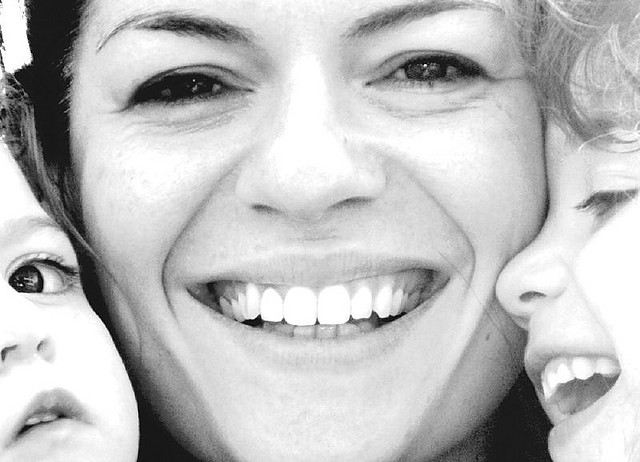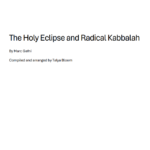Free Feeling: Using Emotions for Liberation, by Sally Kempton
 Practice can change your relationship to emotions, so that instead of being swamped by certain feeling states, you can hold them, contain them, see into their essence, and ultimately, use emotions in the service of your liberation.
Practice can change your relationship to emotions, so that instead of being swamped by certain feeling states, you can hold them, contain them, see into their essence, and ultimately, use emotions in the service of your liberation.
Many years ago, I walked into the kitchen of my guru’s ashram, and found him shouting at the cooks. Force- waves of anger were bouncing around the room, almost visible to the naked eye. Then, in mid sentence, he turned, saw us standing there, and smiled. The energy in his eyes went soft. ‘How did you like the show?” he asked. Then, chuckling, he slapped the head cook playfully on the back, and walked away. The cooks giggled, and went back to work, galvanized by the energy he had injected into the afternoon.
That moment changed my understanding about emotions. The clarity and fluidity with which he had shifted from intense anger to good humor was only part of it. More interesting, I felt, was the fact that he had been using anger as a teaching tool. Was he really angry? I don’t know. All I know is that he seemed able to ride the wave of his anger with perfect easiness, and let it pass without a trace.
One of the ideals of yogic freedom is detachment from emotions. It’s a basic axiom, in fact, that an advanced practitioner has perfected the ability to control, transcend, or at least be a disengaged witness of his emotions. Yet because we have so few models of what genuine detachment looks like, we tend to confuse yogic detachment with being buttoned up, or unemotional, or indifferent.
My teacher was modeling something quite different. As I saw it at the time, he was demonstrating a kind of freedom in emotions. This allowed him to work with emotional expression as an artist or an actor might work with a palette of feelings in order to inspire others, or induce a shift in the situation around him. The secret was that he was able to be conscious within the emotion.
Most people assume that a good spiritual practitioner never gets carried away by emotion–at least not by negative emotion. It can leave you disconcerted when, even after five, 10, or 20 years of practice, you become swamped by fear when you’re in an unfamiliar situation, or feeling waves of jealousy arise as you listen to your lover speaking to another woman in the same intimate way he speaks to you.
Yet the deeper truth is that spiritual practice will not eliminate negative emotions. Emotions are part of the palette of life, part of the way consciousness moves. Not only can’t you get rid of them, but you’d feel empty and impoverished if you did. Practice can change your relationship to emotions, so that instead of being swamped by certain feeling states, you can hold them, contain them, see into their essence, and ultimately, use emotions in the service of your liberation.
In the tantric tradition, its understood that every emotion has an enlightened as well as an egoic side. Egoic sadness is an expression of the ego’s sense of emptiness and loss, a depressed reaction to the blows dealt by life. But we can also experience essential sadness, which is one of the flavors of compassion, and which comes up in recognition of the innate poignancy of life. As sadness softens the heart, fear gives sharpness and clarity; at the survival level, it heightens our perception in times of danger, while at a subtler level, fear morphs into a mind expanding awe when we contemplate God’s immensity of the sky, or the complex mystery of nature.
Anger can be the ego’s response to frustrated desire, but it also shows up when we care so deeply about a person or a task that we are willing to focus sharply on correcting something that doesn’t work. It can also be a way of creating energy in a situation. Tukaram Maharaj, the 16th century poet-saint, used to write angry poems to God, accusing God of deliberately concealing himself. His great skill was to use his anger to generate energy in his practice, to break through barriers in his inner world.
As spiritual practitioners, our real goal is not just to control emotions, but to touch and live in the enlightened expressions of these feeling states. In other words, we want to become masters of emotions not so we can become free of them, but so that we can become free in them. Why else do human beings long so much for emotional authenticity? Its not that we want to be authentic to our temper tantrums or fits of hurt feelings. Its because we intuit the potential for richness and beauty that exists in our feelings once we’ve freed ourselves from the conditioning that keeps emotion tied to childhood pain.
Flavors of Feeling
A radical key to the enlightened expression of emotion can be found in the theory of rasas, emotional flavors, first propounded in the Treatise on Aesthetics by the 10th century Kashmiri sage Abhinavagupta. Abhinava was a philosopher and an enlightened yogi, whose unique way of being was to approach life as an art form. He saw human beings as unique microcosms of the divine, each playing in her own universe, using feelings and emotions as their palette for creating each moment as a work of art. As artists of feeling, we need to learn how to work with emotions, each of which has its own essential rasa, or flavor, and each of which is an indispensable part of the tapestry of human expression.
The Sanskrit word rasa is sometimes translated as flavor, but it also means ‘juice’–the luscious essence of something. The sweet taste of a ripe plum is its rasa, its essence. It’s the rasa in food that makes it tasty, that makes us want to eat it. In a deeper sense, rasa is the juiciness in life, the subtle lusciousness that gives the world its savor. Without rasa, life feels literally dry and flavorless.
The notion of rasa comes from Ayurveda, the traditional Indian medical science. Ayurvedic medicine recognizes six basic rasas, or tastes–sweet, salty, sour, bitter, pungeant, and astringent, each of which has an important effect on the body. According to ayurveda, a healthy diet is supposed to include all 6 tastes.
Nine Emotional Moods
Abhinava took this insight about rasa and applied it to the emotional resonances in music, dance, and drama–and by extension, to life. He identified nine emotional rasas, or moods. As you read through the list below, you’ll probably recognize that every emotional reaction you have goes with one of these rasas–not just in art, but in your inner life. These nine rasas are:
Erotic–the flavor of love and romance
Comic–the flavor of laughter
Pathetic or compassionate–the flavor of sorrow
Furious–the flavor of anger
Heroic–the flavor of noble and courageous ardor
Terrible–the flavor of being scary or scared
Odious–the flavor of being disgusting, or repulsive.
Marvelous–the flavor of wonder or amazement
Peaceful–the flavor of serenity or stillness
When you’re thinking about seeing a movie, you’ll often make your choice on the basis of its rasa. You go to see a movie like Friends with Benefits movie because you’re in the mood for the erotic (romantic) with a flavor of the comic. You’d choose a film like Lethal Weapon for a taste of the heroic and furious, perhaps Resevoir Dogs to revel in the odious. Not everyone likes every rasa, of course. But it’s interesting to note that truly universal works of art have many rasas. Shakespeare’s tragedies, for example, always had a bit of the comic, a bit of the terrible, a bit of the heroic, a bit of the odious, a bit of the pathetic–and in many cases, a flavor of the erotic.
Your Flavor Range
If you look at your emotional life, you’ll notice immediately that your emotional energy tends to flow between four or five of these different rasas, and to occasionally touch others. I generally find myself hanging out in the peaceful, the pathetic, and the erotic rasas, with periodic shifts into the comic. But that doesn’t mean that I don’t regularly slip into the fearful, the furious and sometimes even the heroic–and I’ve noticed that when things get too peaceful I’ll generally look for excitement by getting myself scared or angry. I have my own methods for arousing fury or fear in myself, and if you think about it, so do you. Some people do it by reading reports on what’s happening to the oceans, or watching at tv news. Others go to horror movies or ride rollercoasters or tell gross jokes. Of course, we often engage these rasas unconsciously, and any rasa can become problematic if we over-emphasize it. But the essential impulse behind engaging any one of the rasas is to create more aliveness. Put simply, our consciousness needs a wide palette of emotional experience, and constantly moves to create it–internally as well as on the outside.
I always remember one moment that occurred during my father’s last illness. he two of us slipped and fell down as I was helping him get to the bathroom. As I was hauling him to his feet, his pajamas fell down. I burst out laughing. It was involuntary: the laughter just bubbled up out of me, and of course I was appalled at myself. “I’m so sorry,” I said. “I wasn’t laughing at you.”
“Oh, I understand,” my father said. “It’s gallows humor.” And he laughed too.
In fact, the laughter was a release, a way of balancing the rasas in a situation that was both terrible and pathetic. Had I suppressed the laughter, the painful energy would not have been able to move, and we would have stayed stuck in the pathos of it. There’s an innate wisdom in the way emotional energy moves when it’s allowed to follow its natural course. Comedy lurks inside even the most terrible situation, just as pathos is the other face of comedy. If we are willing to accept the way emotions move, we can appreciate the miraculous fluidity with which our inner world keeps rebalancing itself. Then, when a poignant romantic moment morphs into an argument, instead of mourning the loss of the erotic rasa and wondering what went wrong, you can enjoy the sudden emergence of the furious. All these emotional flavors are part of the tapestry of human life. You can’t keep any of them out.
The theory of rasas, in short, provides a framework for enjoying the rise and fall of emotional states with something like the appreciation we’d experience at a movie. Our emotions only become problematic when we identify with them, get stuck in them, when we privilege certain emotions and try to deny others. But if you have the right combination of open-heartedness, receptivity, and detachment–attitudes that Abhinava Gupta considers proper to an engaged spectator–then even the most painful feeling state becomes full of interest, even entertaining. You can recognize the rasas–including the difficult or problematic ones–as part of the tapestry of your human expression. This doesn’t mean that you give into violence or exploitative behavior. But it does let you honor our own emotional expressions, even the apparently unacceptable ones. When you can be in a particular rasa without judging it, or trying to hang onto it, or projecting it onto someone else, that’s when you begin to be truly free in your emotions. Free, of course, in the yogic way which always includes a natural discipline and sense of proportion, a built in recognition that we aren’t just our emotions.
Observing the Play
When you begin working with emotional rasas, it’s often enough just to observe them. You might try it first during meditation or shavasana, or when you’re riding in a car, or taking a walk. Begin with recognizable emotions, like love or anger. When you notice a particular feeling state arising, try to identify it–anger, guilt, pride mixed with embarrassment–then stand back from it for a moment, like a spectator at your own emotional drama.
As you watch the play of your own emotions, you begin to know them more intimately. You learn the feel of different nuances of joy, the difference in texture between irritability and full-blown anger, the sharp burn of fear gripping your stomach or knotting your shoulders, and the soft lassitude of erotic opening. You can even feel the approach of a particular emotion as it begins to appear in your field. And this is the first stage of mastery. Once you can discern the initial bud of a strong feeling, you have a better chance of being able to choose what to do with it–say, whether to deflect a burst of fury, channel it into some sort of physical activity, or express it.
At this point, your practice of balancing emotion begins to become less of a discipline and more of an artistic practice. The art of Indian cooking is all about the balance of flavors. If a dish is too spicy, you add some sweet. If it’s bland, you add a bit of the pungent. In the same way, you can learn to inject unexpected flavors into your own emotional mix. Every rasa has its place. We may not believe we like the feeling of disgust, yet one of the most popular perfume fragrances, jasmine, carries within it the slight odor of animal decay–and that touch of the odious is part of what gives a jasmine-flavored perfume like the classic Joy its allure. So it is with certain emotions.
In my practice of working with emotional rasa, I was surprised to discover that as I learned how to recognize the textures of my own emotional world, I became comfortable with feelings that I had never allowed myself to admit to consciousness, much less express. At moments, I’d even find myself trying on different emotional shadings. I discovered that I liked the feeling of the heroic, and that there was a certain secret satisfaction in acting scary. For instance, a certain quality of cold rage that I had often deployed unconsciously suddenly became identifiable. I began to see that this aspect of the terrible rasa could be useful when I could use it skillfully and with discrimination–for instance, to scare away the cat who was trapping birds in my garden, but not as a way of distancing myself from friends and partners.
That was when I began to intuit what it was that my teacher had actually shown me in that long ago encounter. A Kabbalistic text says that to be a true master means to have mastery over your heart. Not in the sense of being able to control emotions but to have free access to all your emotions. A master is one who can recognize the unique texture of each feeling, and has learned to deploy each emotion authentically at the exact moment it is needed. If you can do that, the teaching says, you can actually use emotional expression to realign yourself and others with God.
When my teacher yelled at the kitchen workers, he was actually realigning them. His anger was famous, and when I was its target, I often experienced it like a sharp burst of awakening energy that kindled in me a feeling of excitement flavored with intense bliss. His anger was like a depth charge that broke up stuck energy, galvanized you, focused your mind on what was truly important. In similar, if less dramatic ways, when you’ve mastered emotion, your emotional expression will naturally align you to the need of the occasion. You can cry when its time for grief, and laugh when its time to celebrate, and both your tears and your laughter will connect you to the answering current in other hearts. You can say “I love you” and genuinely mean it, and when fear rises up, you can inhabit that fear so that it wakes you up rather than shutting you down. Your emotions, in short, become not just authentic, but inspired and inspiring. They become like instruments in a perfectly attuned orchestral piece, or a choral for blended voices. Then, you are both actor and spectator in the play of feeling that is creating your world. You play within the flavors and tastes that rise and fall, with the exquisite enjoyment of a true connoisseur.
Try this as a meditation: Sit for a few moments, allow feelings and emotions to arise as they will, seeing them all as flavors or colors of the Self, threads in the weave of your consciousness, details in the tapestry of the great consciousness that has become all this. And notice that when you become the spectator at the emotional dance, the dance becomes interesting, even beautiful.
Try this: Spend a day being actively conscious of how the rasas show up in your life. Identify the rasas you move through. See the rasas being played out in conversations, in events you see on TV, in situations you pass on the street.








